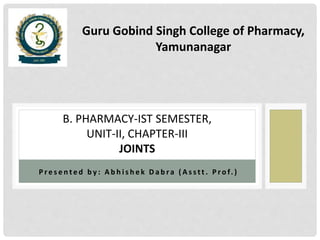
5. Joint.pptx
- 1. P r e s e n t e d b y : A b h i s h e k D a b ra ( A s s t t . P r o f. ) B. PHARMACY-IST SEMESTER, UNIT-II, CHAPTER-III JOINTS Guru Gobind Singh College of Pharmacy, Yamunanagar
- 3. Function of Joints 1. Serve as functional junctions between bones. 2. Bind bones, and other related tissues together. 3. Allow bone growth to occur. 4. Permit certain structures to change shape during childbirth (i.e. pubic symphysis). 5. Enable the body to have movements, lever actions, and body posture.
- 4. Classification of Joints A. According to the type of tissue at thejoint: 1) Fibrous joint -- uses fibrous connective tissue to articulate bones. 2) Cartilaginous joint -- uses hyaline cartilage and/or fibro- cartilage to articulate bones. 3) Synovial joint -- uses auricular cartilage, synovial membrane, and ligaments to articulate bones. B. According to the amount of movement at the joint: 1) Synarthrotic joint -- Immovable joint. 2) Amphiarthrotic joint – Slightly movable joint. 3) Diarthrotic joint -- Freely movable joint.
- 5. 1.Fibrous Joints • • a) Occur between bones that have close case contact ( e.g. cranial bones, tibia and fibula, ulna and radius). b) Fibrous connective tissue fastens the bones tightly. c) Small amount of movement (amphiarthrosis) or no movements at all is possible (synarthrosis). d) Subdivided into: -- Syndesmosis = uses interosseous ligaments; amphiarthrotic (e.g. distal end of tibia and fibula). -- Suture = uses sutural ligaments; synarthrotic (e.g. cranial sutures in the skull). -- Gomphosis = uses periodontal ligaments; synarthrotic (e.g. joining teeth to maxilla and mandible).
- 7. 2. Cartilaginous joints a) Hyaline cartilage and/or fibro cartilage form the joint. b) Usually slightly movable (amphiarthrotic) and very strong. c) Subdivided into: • -- Synchondrosis = uses hyaline cartilage, synarthrotic(e.g. between the first rib and manubrium). • -- Symphysis = uses hyaline cartilage at the ends of bones, and a layer of fibrocartilage at the center; amphiarthrotic (e.g. intervertebral disk, pubic symphysis).
- 9. 3. Synovial Joints • a) Most joints are synovial joints. • b) Usually freely movable (diarthrotic). • c) Contain articular cartilage (at the ends of bones), joint capsule (fibrous connective tissue surrounding the joint), and synovial membrane (inner lining of the joint capsule). • d) Subdivided into: • -- gliding = allows back and forth movement (e.g. carpals sliding onto one another during wrist movements). • -- hinge = allows folding movement (e.g. elbow joint). • -- pivot = allows rotation around an axis (e.g. between atlas and axis at the odontoid process).
- 11. • -- condyloid = allows all movements except rotation (e.g. between metacarpals amid proximal phalanges). • -- saddle = allows all movements except rotation (e.g. between carpals and metacarpals). • -- ball - and - socket = allows all movements (e.g. shoulder joint and hip joint).
- 12. Disorders of Joints 1. Dislocation = displacement of articulating bones of a joint, as a result of a fall or unusual body movements. 2. Sprain = results of overstretching or tearing of the connective tissue ligament, or tendon at a joint. 3. Bursitis = inflammation of the bursa (a sac filled with synovial fluid at the synovial joint) caused by excessive use of a joint. 4. Arthritis = inflammation of a joint that causes swelling and pain (rheumatoid arthritis is an autoimmune disease where white blood calls attack the joint tissues; while osteoarthritis is a natural degeneration of joint tissues).